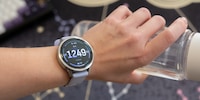

An affordable Garmin watch proves to be an expert motivator
My plan worked. I finished another half marathon in under two hours. And one of Garmin’s most affordable watches helped me to get there.
Although I’m a dedicated Apple Watch user, I’ve been less than 100% loyal since July, when I started wearing a Garmin. In addition to the Apple Watch, of course. Why? My motivation to run had gradually but steadily waned. Sometimes it was too hot, sometimes I convinced myself to read a good book instead. The graph in Apple’s Fitness app was slowly on its way down. I realised what this meant during a 10-kilometre run in the ZKB Zürilauf Cup (website in German). I dragged myself to the finish line with a disappointing time. This couldn’t go on; I had to do something about my slacking!
I remembered a Garmin running watch – the Venu – that I used years ago, before I became an Apple user. It was a fond memory, so I picked up a current model to start running more. My colleague Siri’s testing out the top models. I didn’t want to spend a lot of money anyway, so I went for the entry-level Forerunner 165.

I was surprised by what you get for relatively little money: a colour OLED touch display, plus practical buttons, sensors for heart rate, temperature, altitude, acceleration, ambient light, a compass and positioning via GPS, Glonass and Galileo. And all this with an eleven-day battery life. It sounds impressive, but it drops significantly when location data’s constantly being retrieved during a run. Nevertheless, the battery easily lasts for a week with three or four workouts.
Half marathon training with the Forerunner
The main aim of my test was to find out how good and useful the Forerunner’s sensors are and how it’d prepare an athlete for a half marathon. I create a Garmin Run Coach plan by entering information including height, weight and gender and select my target time for the 21.1 kilometres. There are still ten weeks until the event. In the app, I set which days I can and want to train.
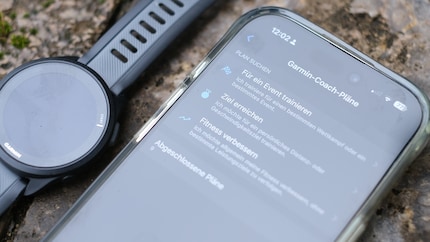
Based on this, my training plan is calculated for me. The first activity’s an assessment run. I have to run for ten minutes at the specified pace. Well, I’m not sure pace is the right word. I never normally jog that slowly. My watch constantly beeps, warning me that I’m going too fast. The display also shows a green zone where my pace should be. If the small arrow’s too far to the right, I slow down.
Preparation in phases
Reaching the target pace is the biggest challenge in the days that follow. Rightly so. It’s really important because, as every runner knows, only running slowly can make you truly fast. My ten-week plan includes different phases :
- «Basic» aims to improve aerobic fitness.
- «Build» with increasing intensity to improve aerobic range.
- «Max» is the «peak performance phase» and lasts almost three weeks; this involves anaerobic training with sprints and multiple intervals.
- «Reducing training», meaning reducing training volume while maintaining the same intensity, which also reduces the risk of injury.
- «Target event» for race day, the shortest, one-day phase.
I run whatever Garmin tells me to and puts in my calendar. Sometimes it’s a relaxed half-hour, sometimes it’s a session with tough intervals, sometimes it’s a long run. And I gratefully accept the few recovery days.
After just two weeks, I can already feel the effect. I feel as fit as I felt a few years ago. The Garmin app supports me with a psychological boost. The data from my completed workouts is used to calculate a time I could achieve on 20 September, the day of my half marathon. It also calculates my «fitness age». This is very flattering, as the algorithm estimates me at 38 instead of my actual age of 47. My editorial colleague and sports buddy Olla is officially only four years younger than me, but his «fitness age» is 20. Either the algorithm’s crazy, or he has a fountain of youth at home.
More and more training
For the first three weeks, I’m on holiday and training like crazy. My goal time for the half marathon improves with each run. Rather than my initial goal of 1:58, it soon shows me I could finish 10 minutes faster. Mission accomplished, I think. I could train less now, just maintain my pace. Instead, I keep a daily task in my calendar – except for the two days of the week I’ve set as training-free. Garmin doesn’t give me a break.
It bothers me. I ask Garmin how the runtime forecast and training plan relate to each other. The answer comes via e-mail from Laura:
The predicted finish time isn’t your training goal; it’s a performance forecast that shows what result you could probably achieve based on your current fitness levels.
Well, the week before the Greifenseelauf, the app predicted a time of 1:42. According to Garmin, this is supposed to be «very reliable», but I think it’s unrealistic. There are a number of inclines along the route – as well as the heat factor, which, based on experience, slows me down.
The Garmin expert has another piece of good advice: I should think of the training plan’s targets as a «motivational feature». The watch’s algorithm’s programmed to continually push me to achieve better results. Always demanding, never kind.
Nocturnal data collection
To predict performance, Garmin accesses data I generate while wearing the watch, including at night. How long and well I sleep influences how many hours it takes to recover after a run. Garmin isn’t consistent here. After a long run, for example, the watch showed 39 hours of recovery time, while I was already planning another workout for the next day.
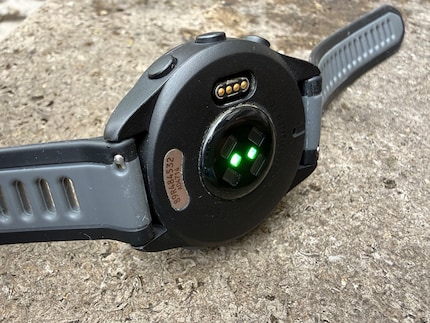
More features than I need
The Forerunner 165’s an entry-level model «for beginners that helps you meet your goals», as Garmin describes it on its website. That’s almost too modest, because the sports watch can do so much more. I activated the payment function and used it to pay at the farm shop as well as tracking walks, my bike ride to the office, a hike in Ticino and a few swim workouts. And you can do even more: from strength training to yoga, the list includes an impressive 25 sports. That’s far more than I’m even capable of.
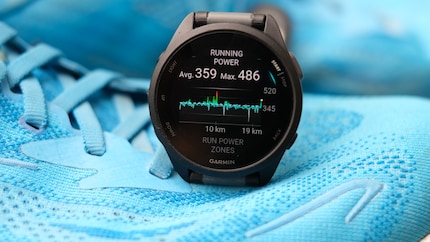
Speaking of too much, it feels like the Forerunner 165’s constantly measuring me from head to toe. I only looked at a lot of the data once, then never again. As a recreational runner, ground contact times, vertical oscillations or running power in watts are only of limited interest. It’s more helpful to find out after training whether I’ve done anything to improve my aerobic or anaerobic performance.
The Forerunner 165’s now a permanent fixture in my daily routine. After I wake up, I check my sleep analysis and the status of my «Body Battery».
So, will I be running with the Apple Watch on my left wrist and the Garmin on my right one for the long term? Probably not. After the intensive training phase for the half marathon, I’ll dial down the intensity a bit. I’ll still wear the Forerunner for runs, but take it off again afterwards.
Oh yes, I should also mention that I achieved my goal at the Greifensee Run. I trained for 1:58 hours and – in late summer temperatures of 28 degrees – I crossed the finish line in 1:56:35. I don’t know how I could have finished a full ten minutes faster.
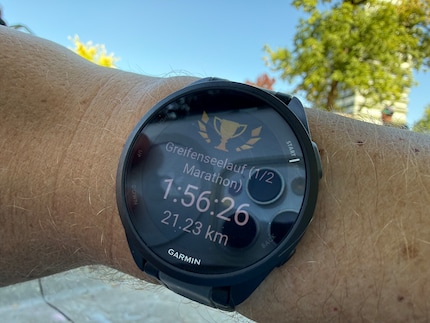
Alternatives: Adidas, Nike etc.
The Apple Watch – when combined with other Apple devices – is the clear winner in my household and remains my go-to smartwatch. While Apple’s been trying to make its watch more appealing to recreational athletes for a few years now, after my Garmin phase, I now realise that there are still things missing.
That’s why I’m looking for guided training plans with an app for my watch. Adidas, for example, charges 10 Swiss francs per month for personalised training sessions in its Running app that continually adapt to your progress.
Asics offers the Runkeeper app for the same price, and Runna is also available in a similar price range – the annual subscription’s available for 120 Swiss francs.
The running coach in the Nike Run Club essentially offers the same thing as Adidas. With one important difference – the dynamic training plans are free.
What are your experiences with Garmin? Are you an occasional runner who’s happy with the Apple Watch (or your chosen smartwatch)? Do you have a good app recommendation? Let me and the Community know in the comments.
In a nutshell
A friendly taskmaster on your wrist
Garmin knows what I need as an athlete: a watch with multiple sensors that records enough data for me to enjoy after a run – and get motivation for the next workout. I happily take note of the overly optimistic finish time predictions, but I don’t take them seriously.
I don’t feel that the Forerunner lacks anything. It’s lightweight and practical, and the app’s comprehensive yet easy to understand. Buying the watch gives you lifetime access to various training plans, for which other apps usually charge around 100 Swiss francs per year. After two years, your investment in the Forerunner 165 will already have been paid off. Let’s hope Garmin doesn’t move previously free features to the recently launched paid Connect Plus service.
One minor drawback for me is the design. It certainly looks like a sports watch. And it is. But the rubber strap and the rather high profile are a bit uncomfortable at night.
Pro
- Records a lot of different sports
- Motivating training plans
- Extremely easy-to-read display
- Extensive data
- Good combination of touch and button controls
- Lasts several days without charging
- No additional costs for training plans
Contra
- Unrealistic target time forecasts
- Somewhat functional design
- Proprietary charging cable
Journalist since 1997. Stopovers in Franconia (or the Franken region), Lake Constance, Obwalden, Nidwalden and Zurich. Father since 2014. Expert in editorial organisation and motivation. Focus on sustainability, home office tools, beautiful things for the home, creative toys and sports equipment.
